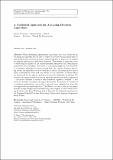Files in this item
A combined approach for analysing heuristic algorithms
Item metadata
| dc.contributor.author | Jeroen Corstjens | |
| dc.contributor.author | Dang, Nguyen | |
| dc.contributor.author | Depaire, Benoît | |
| dc.contributor.author | Caris, An | |
| dc.contributor.author | De Causmaeckers, Patrick | |
| dc.date.accessioned | 2019-08-09T23:41:33Z | |
| dc.date.available | 2019-08-09T23:41:33Z | |
| dc.date.issued | 2019-10-01 | |
| dc.identifier | 258216742 | |
| dc.identifier | c50a0a06-1dbf-4e9c-be42-a0df64d9f975 | |
| dc.identifier | 85051635264 | |
| dc.identifier.citation | Jeroen Corstjens , Dang , N , Depaire , B , Caris , A & De Causmaeckers , P 2019 , ' A combined approach for analysing heuristic algorithms ' , Journal of Heuristics , vol. 25 , no. 10 , pp. 591–628 . https://doi.org/10.1007/s10732-018-9388-7 | en |
| dc.identifier.issn | 1381-1231 | |
| dc.identifier.other | ORCID: /0000-0002-2693-6953/work/55643846 | |
| dc.identifier.uri | https://hdl.handle.net/10023/18288 | |
| dc.description.abstract | When developing optimisation algorithms, the focus often lies on obtaining an algorithm that is able to outperform other existing algorithms for some performance measure. It is not common practice to question the reasons for possible performance differences observed. These types of questions relate to evaluating the impact of the various heuristic parameters and often remain unanswered. In this paper, the focus is on gaining insight in the behaviour of a heuristic algorithm by investigating how the various elements operating within the algorithm correlate with performance, obtaining indications of which combinations work well and which do not, and how all these effects are influenced by the specific problem instance the algorithm is solving. We consider two approaches for analysing algorithm parameters and components—functional analysis of variance and multilevel regression analysis—and study the benefits of using both approaches jointly. We present the results of a combined methodology that is able to provide more insights than when the two approaches are used separately. The illustrative case studies in this paper analyse a large neighbourhood search algorithm applied to the vehicle routing problem with time windows and an iterated local search algorithm for the unrelated parallel machine scheduling problem with sequence-dependent setup times. | |
| dc.format.extent | 38 | |
| dc.format.extent | 2377278 | |
| dc.language.iso | eng | |
| dc.relation.ispartof | Journal of Heuristics | en |
| dc.subject | Functional analysis of variance | en |
| dc.subject | fANOVA | en |
| dc.subject | Multilevel regression | en |
| dc.subject | Algorithm performance | en |
| dc.subject | Vehicle routing problem with time windows | en |
| dc.subject | Large neighbourhood search | en |
| dc.subject | Iterated local search | en |
| dc.subject | Unrelated parallel machine scheduling problem | en |
| dc.subject | QA75 Electronic computers. Computer science | en |
| dc.subject | QA76 Computer software | en |
| dc.subject | T-NDAS | en |
| dc.subject | BDC | en |
| dc.subject.lcc | QA75 | en |
| dc.subject.lcc | QA76 | en |
| dc.title | A combined approach for analysing heuristic algorithms | en |
| dc.type | Journal article | en |
| dc.contributor.institution | University of St Andrews. School of Computer Science | en |
| dc.identifier.doi | 10.1007/s10732-018-9388-7 | |
| dc.description.status | Peer reviewed | en |
| dc.date.embargoedUntil | 2019-08-10 |
This item appears in the following Collection(s)
Items in the St Andrews Research Repository are protected by copyright, with all rights reserved, unless otherwise indicated.

